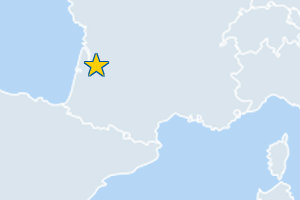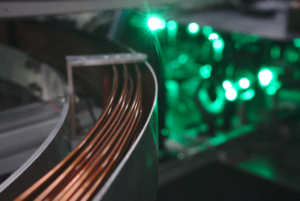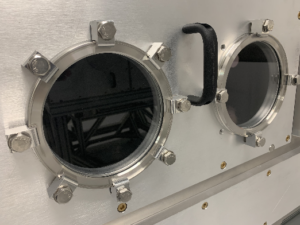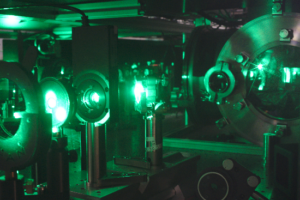CELIA (Bordeaux, France)
Centre Lasers Intenses et Applications, University of Bordeaux, CNRS
CELIA is a centre of excellence in lasers and their interaction with matter. Research is performed on laser development, ultra-short intense laser matter interactions and applications, from the physics of hot dense plasmas to laser-molecule or laser-atom interactions. 4 state-of-the art laser drivers based on Ti:sapphire and Ytterbium feed 9 fully-equipped end-stations including secondary XUV and X-ray sources.

Research highlights
Attosecond spectroscopy
Laser induced electron diffraction in chiral molecules
Laser-induced electron diffraction has emerged in the past decade as a promising tool to resolve molecular structures with attosecond temporal and Angström spatial resolution. An experimental campaign at CELIA with N. Dudovich’s team (Weizmann Institute, Rehovot) has shown that if the linearly polarized strong laser field used in this technique was replaced by an elliptical one, the method became sensitive to the chirality of the target. The enantiosensitivity of the collisions between electrons and chiral molecules had been predicted in 1999 but never observed up to now. [Phys Rev X 14, 011015 (2024)]
Strong-field ionization with a twist
The combined influence of the spin and orbital angular momentum of light in light-matter interactions is the subject of many investigations. A team led by D. Rajak (ELI, Szeged) has carried out measurements at CELIA revealing a strong influence of OAM in the angular distributions of photoelectrons produced by elliptically polarized strong laser fields. The process was also shown to be weakly but definitely sensitive to the chirality of the target. [Manuscript in preparation]
Condensed Matter
Charge-density-wave fluctuations in TiSe2 accessed by ultrafast nonequilibrium dynamics
We used femtosecond time-resolved extreme-ultraviolet (XUV) momentum microscopy at the CELIA platform to investigate 1T-TiSe2, a layered quantum material that undergoes a charge-density-wave (CDW) transition near 200 K and is widely discussed in terms of intertwined excitonic and phononic driving forces. During this beamtime we directly resolved spectral signatures of CDW fluctuations at 295 K.
Pump–probe measurements with nonresonant ultrafast excitation allowed us to track the transient melting and recovery of these short-range CDW correlations. Strikingly, a coherent amplitude-mode oscillation, typically associated with the ordered CDW phase, persists at room temperature, revealing that a collective lattice channel remains dynamically engaged well above the transition. Analysis of the time-, energy-, and momentum-dependent photoemission data indicates that electron-phonon coupling governs the fluctuation regime at elevated temperature. [Fragkos et al., arXiv:2507.12430 [cond-mat.str-el] (2025) – submitted at PRX ]
Laser Processing
X-ray emission during laser processing
Possible laser-induced X-ray emission during high-power laser processing on different materials has been measured at the new RAFALE installation. Different burst-modes and a comparison to the regime of repetitive single pulses have been applied using the same laser source. The results will be published soon.
Expertise
 CELIA is a joint research unit (UMR5107) involving a partnership between Bordeaux University (UB), the Atomic Energy Commission (CEA) and the National Scientific Research Center (CNRS). CELIA offers an outstanding opportunity for gathering expertises in laser development, strong Field and/or Ultra-High Intensity Physics, Inertial Fusion for Energy (IFE) and ultrafast laser material processing for industrial applications. CELIA is an active member of the European Large Lasers Network Laserlab-Europe.
CELIA is a joint research unit (UMR5107) involving a partnership between Bordeaux University (UB), the Atomic Energy Commission (CEA) and the National Scientific Research Center (CNRS). CELIA offers an outstanding opportunity for gathering expertises in laser development, strong Field and/or Ultra-High Intensity Physics, Inertial Fusion for Energy (IFE) and ultrafast laser material processing for industrial applications. CELIA is an active member of the European Large Lasers Network Laserlab-Europe.

With a total staff of 110 scientists, engineers and students, CELIA is a large research Center with broad expertise in laser/matter interactions, generation of ultra-short pulses of Extreme UV radiation, from picosecond down to attosecond durations, with beamlines dedicated to applications in molecular, solid-state physics and ultrafast material processing; of X-rays – broadband soft X-rays, and hard X-rays up to the GeV range with applications ranging from time resolved studies or phase contrast imaging in warm dense plasmas up to investigations with a high societal impact such as medical radiography. CELIA displays a specific expertise in the development of high average power, high repetition rate lasers. CELIA has also extended its activity in laser processing and complex correlated spectroscopies in strong connection with industrial partners. Finally, CELIA possesses a particular experience, experimental and theoretical, in high-energy density physics, and physics of hot and dense plasmas. Several spin-off companies, with up to 200 direct new jobs was born at CELIA awarded in 2007 by National Prize for Innovation and Industrial Property (INPI).
Services for industry
Biomedicine
Bioprinting – Bench develomement, characterisation , Demonstration and validation of bioprinting with mid-IR lasers for a Bioprinting company
Instrumentation
Testing – Laser Damage tests with ultrashort pulse for dielectric deformable membrane for a manufacturer of deformable mirror.
Metrology – Testing and Benchmarking of ultrafast laser instrumentation for a manufacturer of ultrafast laser diagnostics
Photonics/Lasers
Feasibility studies – Evaluation of a frugal laser system by laser processing of biomaterial for a laser manufacturer. GHz burst mode laser processing for integrated device manufacturer.
Electronics
Laser development – Development of high power high repetition rate short pulse laser technologies for laser manufacturers.
Equipment offered to external users
 CELIA proposes not just lasers systems, but really integrated end-stations dedicated to a number of specific applications, very much in the spirit of synchrotron radiation centers. CELIA provides to external users (>40% of beamtime) 7 fully equipped and dedicated end-stations fed by 4 state-of-the-art reliable laser systems (80% operating time-7 full-time employees): Ti:Sa AURORE (20 mJ, 1kHz, 25 fs), Ti:Sa ECLIPSE (150 mJ, 10 Hz, 35 fs), Yb:fiber BLASTBEAT (2*50W 130 fs, 0.166-2 MHz) and Yb based RAFALE (TANGOR Single pulse to 40 MHz, GHz burst mode, 500 fs).
CELIA proposes not just lasers systems, but really integrated end-stations dedicated to a number of specific applications, very much in the spirit of synchrotron radiation centers. CELIA provides to external users (>40% of beamtime) 7 fully equipped and dedicated end-stations fed by 4 state-of-the-art reliable laser systems (80% operating time-7 full-time employees): Ti:Sa AURORE (20 mJ, 1kHz, 25 fs), Ti:Sa ECLIPSE (150 mJ, 10 Hz, 35 fs), Yb:fiber BLASTBEAT (2*50W 130 fs, 0.166-2 MHz) and Yb based RAFALE (TANGOR Single pulse to 40 MHz, GHz burst mode, 500 fs).
|
Laser Parameters |
RAFALE |
BLASTBEAT |
AURORE |
ECLIPSE |
|
Source Type |
Laser |
Laser |
Laser |
Laser |
|
Laser Type |
Yb:DPSSL |
Yb:fiber |
Ti:sapphire |
Ti:sapphire |
|
Central Wavelength |
1030 nm |
1030 nm |
800 nm |
810 nm |
|
Spectral Bandwidth FWHM |
3 nm |
15 nm |
55 nm |
50 nm |
|
Beam Shape |
Gaussian |
Gaussian |
Gaussian |
Gaussian |
|
Pulse Duration FWHM |
500 fs |
130 fs/17fs |
26 fs |
30 fs |
|
Pulse Repetition Rate |
Single Pulse (up to 40 MHz) or Burst-mode (MHz or GHz) |
166 MHz-2MHz |
1 kHz |
10 Hz/1Hz |
|
Maximum compressed Pulse Energy |
500 µJ single pulse / 300 µJ burst energy |
300 µJ @166 kHz |
2x 6 mJ |
150 mJ/2J |
AURORE
AURORE is a newly upgraded (2025) laser facility based on a CPA ti:sapphire emitting laser pulses at 800 nm at a repetition rate of 1 KHz. Two experimental end-stations located in two experimental rooms can be fed simultaneously. With a spectral bandwidth of 55 nm, pulses are recompressed in independents compressors down to 26 fs with a compressed energy of 6 mJ each. A deformable mirror insures a fine control of the final Gaussian shape of the compressed beams. Shorter pulses with a capillary Postcompression can also be offered and a spectral tunability by NOPAs as well.

|
End-Station |
Topics |
Offer |
|
AURORE 1 |
Material Science Gas-phase femtochemistry |
· Nonlinear Optical Parametric amplifier (NOPA) delivering IR and Mid-IR signal and idler TOPAS (0.8, 1.3 and 2µm) · NOPA Tunable VIS-UV beamlines · 10 fs- Capillary postcompression beam line · Time-resolved velocity map imaging (VMI) · Solid State Spectroscopy by HHG |
|
AURORE 2 |
Material Science |
· THz generation · Time-resolved THz Spectroscopy of solids |
BLASTBEAT
BLASTBEAT is based on two synchronized commercial Yb:fiber delivering 130 fs-50 W each at a repetition rate from 166 kHz to 2 MHz at 1030 nm. Shorter pulses (17 fs) are now accessible through a new (2025) postcompression multipass-cell. Harmonics of the fundamental and XUV HHG beamlines can also be provided. BLASTBEAT feeds the CYCLONE endstation fully equiped with VMI, COLTRIMS and a new TR-ARPES
|
End-Station |
Topics |
Offer |
|
CYCLONE |
Gas-phase femtochemistry |
· Two synchronized high repetition rate (166 kHz-2MHz) fiber lasers (1030nm,2x50W, 130fs) · Postcompression multipass cell 17 fs, 200 µJ @ 166 kHz · Harmonics (2nd, 3rd and 4th)? · High flux XUV beamline up to 80 eV · Polarization control oft h harmonics · Time-resolved velocity map imaging · COLTRIMS electron-ion imaging detector for coincidence experiments · Polarization controlled HHG beamline @21eV coupled to Tr-ARPES (Momentum microscope)
|
ECLIPSE
ECLIPSE is a high energy laser facility newly upgraded (2023) to 100 TW based on a CPA ti:sapphire emitting laser pulses at 810 nm. Two experimental end-stations (ECLIPSE2 and ECLIPSE 3) are independently providing 150 mJ of sub -30 fs compressed pulses at a repetition rate of 10 Hz. A new high energy additional amplifier pushes the available energy up to few Joules at a repetition rate of 1 Hz feeding a new end-station ECLIPSE4 with 2J-30 fs pulses.
|
End-Station |
Topics |
Offer |
|
ECLIPSE 2 |
Attoscience |
· High energy HHG (<100eV) · Spatial beam shaping · 10mJ-10fs post-compression beamline
|
|
ECLIPSE 3 |
High energy physics |
· X-ray sources and plasma experiments · X-ray Absorption Near-Edge Spectroscopy (XANES) end-station dedicated to pump–X-ray probe (0.5 to 4 keV) with ps resolution
|
|
ECLIPSE 4 |
Ultra High intensity (>1.1019 W/cm2) Physics
|
· High contrast 1:109@150 ps · Solid or gas Target · X ray detector, electron spectrometer Du to radioprotection clearance: · Energy electron <10 MeV · Energy of X-rays < 10 MeV, · < 1000 shots/day |
RAFALE
RAFALE is high repetition rate laser based on a commercial industrial laser TANGOR feeding three end-stations dedicated to ultrafast laser processing (FEMTOWELD, INSIGHT and BACKSIGHT). 3 nm-spectral bandwidth pulses at 1030 nm are recompressed down to 500 fs with a maximum energy of 500 µJ (Single pulse mode) or 300 µJ (burst mode). Burst mode (in MHz or GHz) is available and an OPA extends the wavelength domain at 1700 nm.
|
End-Station |
Topics |
Offer |
|
FEMTOWELD |
Ultrafast laser processing |
· 3-axis micromachining workstation · 3-axis and 2-axis galvo-scanner heads · Burst-modes available (MHz and GHz) |
|
INSIGHT |
Ultrafast laser processing |
· 3-axis micromachining workstation · OPA option (1700 nm) |
|
BACKSIGHT |
Ultrafast laser processing |
· 3-axis micromachining workstation · Bessel-beam option |
